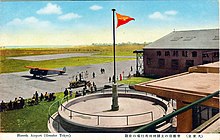Japan Air Transport
This article includes a improve this article by introducing more precise citations. (December 2009) ) |
| Founded | October 30, 1928 |
|---|---|
| Commenced operations | 1929 |
| Ceased operations | December 1938 (merged into Imperial Japanese Airways) |
| Operating bases | Tachikawa, Tokyo (1929-1931) Haneda Airport (1931-1938) |
| Destinations | Manchukuo |

Japan Air Transport Corporation (日本航空輸送株式会社, Nihon Kōkū Yusō Kabushiki Kaisha) was the
History
On 30 October 1928, the Japanese government established the Japan Air Transport Corporation (JAT) as the national flag carrier under the Ministry of Communications. JAT absorbed the Japan Air Transport Institute and two other small companies and began scheduled passenger services in 1929. It initially used the Imperial Japanese Army air base at Tachikawa as its terminal in Tokyo. JAT later moved to Haneda Airport, which was completed in August 1931.
JAT was heavily

This role declined as
JAT shifted its focus to the civilian passenger market and began using new 14-passenger Douglas DC-2s on new, more commercially profitable routes between Japan and Manchukuo in 1936. With the start of the Second Sino-Japanese War in 1937, JAT benefited from a resurgence in military passenger traffic.
In 1938, JAT carried nearly 70,000 passengers, representing 2.6 percent of the world's passenger traffic.
In December 1938, the government established a new airline, Imperial Japanese Airways, as a monopoly for all civil aviation and Japan Air Transport Corporation was merged into the new company.
Aircraft

- Fokker Trimotor(1929-1938)
- Fokker Super Universal
- Nakajima Super Universal (1929-1938)
- Douglas DC-2 (1936-1938)
- Nakajima AT-2 (1937-1938)
Destinations
- Zhoushuizi Airport
- Yeouido Airport
- Tachikawa Airfield 1929-1933
- Haneda Airport 1933-1938
- Kizugawa Airport 1929-1938
- Tokushima Seaplane base 1922-??
Accidents and incidents
- 24 August 1938
- Nakajima Super Universal (J-BJDO) collided in mid-air with a Mitsubishi Ki-1 (J-BIDH) over Omori, Tokyo, killing all five on board both aircraft and 55 on the ground.
References
- ^ Tae Hoon Oum and Chunyan Yu, Shaping Air Transport in Asia Pacific (Taylor & Francis, 2019)
- Best, Martin S. (Spring 2008). "The Development of Commercial Aviation in China: Part 5A: Japanese Airlines in Occupied China and Manchuria". Air-Britain Archive. pp. 17–31. ISSN 0262-4923.
- Wilson, Stuart (1999). Airliners of the World. Australian Aviation. ISBN 1-875671-44-7.
External links
- Early Japanese Civil Aviation Archived 2013-07-29 at the Wayback Machine at Century of Flight
- JAT Timetable, 1929 20th Century Timetable Museum
- JAT Passenger Boarding Ticket, 1936 JCAL
